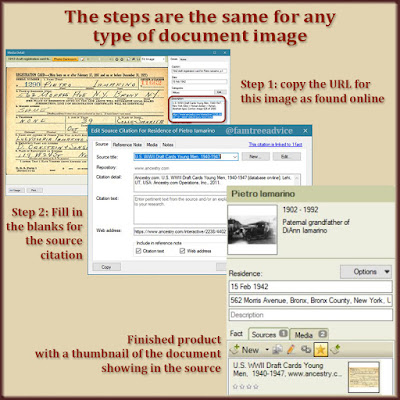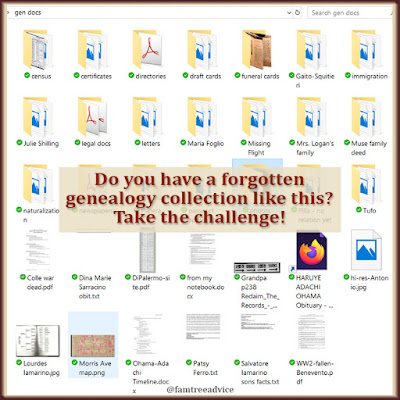This source citation clean-up task is so rewarding, it won't bog you down.
You may remember I recently had a disaster with my family tree software. While synchronizing my Family Tree Maker file with my Ancestry.com tree, the file got corrupted. The only cure was to download my Ancestry tree as a new FTM file.
That blew up my "simple sources" system. Ancestry stores the source information differently than Family Tree Maker. It fed my sources back in a most un-simple way. That forced me to rethink my sourcing process. I had to step up and commit to improving my method.
And I'm glad I did. The bulk of my tree consists of 17th and 18th century Italians. I'm very lucky to have access to high-quality images of many of their vital records. Cleaning up how I cite these sources means I can do the following.
Copy the Source Wherever it Applies
Say I'm working on my 6th great grandfather, Giuseppe Iamarino. His son's 1815 marriage documents included Giuseppe's 1792 death record. I can create a source citation for Giuseppe's death that:
- provides a link to his death record
- says where to find the original (in his town's 1815 marriage records)
- includes the image itself in the citation
Plus, his death record is my only source for the names of his parents, my 7th great grandparents. So I can copy the source for Giuseppe's death date and use it as the source for each of his parents' names.
 |
| It's all a simple copy-and-paste job. |
That's a big improvement over what I was doing. My "simple source" system meant a lot of sharing. For example, everyone with a fact from the 1930 U.S. Federal Census shared the same source. In my family tree, you had to view the notes on a document image to see exactly where it came from.
Last night I found a new document for my grandfather, Pietro Iamarino. It's his World War II draft registration card that was not online before. So I made a new source citation for this card and used it for:
- Grandpa's 15 Feb 1942 home address
- Grandpa's work address in 1942 (I knew he was working for a costume jewelry company, but now I know where!)
- Grandma's shared 15 Feb 1942 home address (Her name is on the card.)
Now anyone viewing my family tree online can see the:
- title
- citation detail
- document image, and
- the exact link to the document online.
 |
| It works for any document you found online. |
An Efficient Shortcut
Here's a new tip I want to share with you today. I've got more than 23,000 people in my tree. Fixing all the citations is a monumental task. So I want to take care of my direct ancestors first. All 293 of them.
Here's how I'll get that done efficiently. While making my Elder Scroll, I created a filter in Family Tree Maker. The filter lets me display only my direct ancestors in the index of people. (See how I used Ahnentafel numbers to show only my direct ancestors.)
It's easy to work my way down that alphabetical list, caring for each person's source citations one at a time. I don't have to worry about missing someone.
 |
| If I can get through all my direct ancestors in a few sessions, it'll all be worthwhile. |
And it's really satisfying. There are lots of cases where I only know someone died "Bef. 10 Aug 1812" because his grandson's 1812 birth record says that his father's father is dead. That connection (fact to source) was getting lost. But now I can go to the grandson, create his birth source citation, and make it the source for his grandfather's death.
Now, I'm not recommending you have a family tree software catastrophe. But I am encouraging you to think about how to make your sources better. Think about the day when your grandchild inherits all your research. Or about the DNA match who's looking at your tree to figure out your connection. How believable will your facts be?
The more traceable your facts are, the more professional your family tree is. And that's been my mission for 3 years. I want you to fortify your family tree—and have fun while you're doing it.



